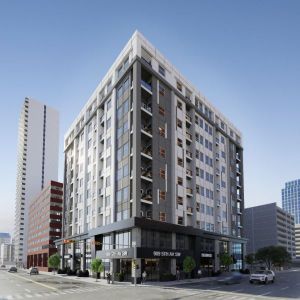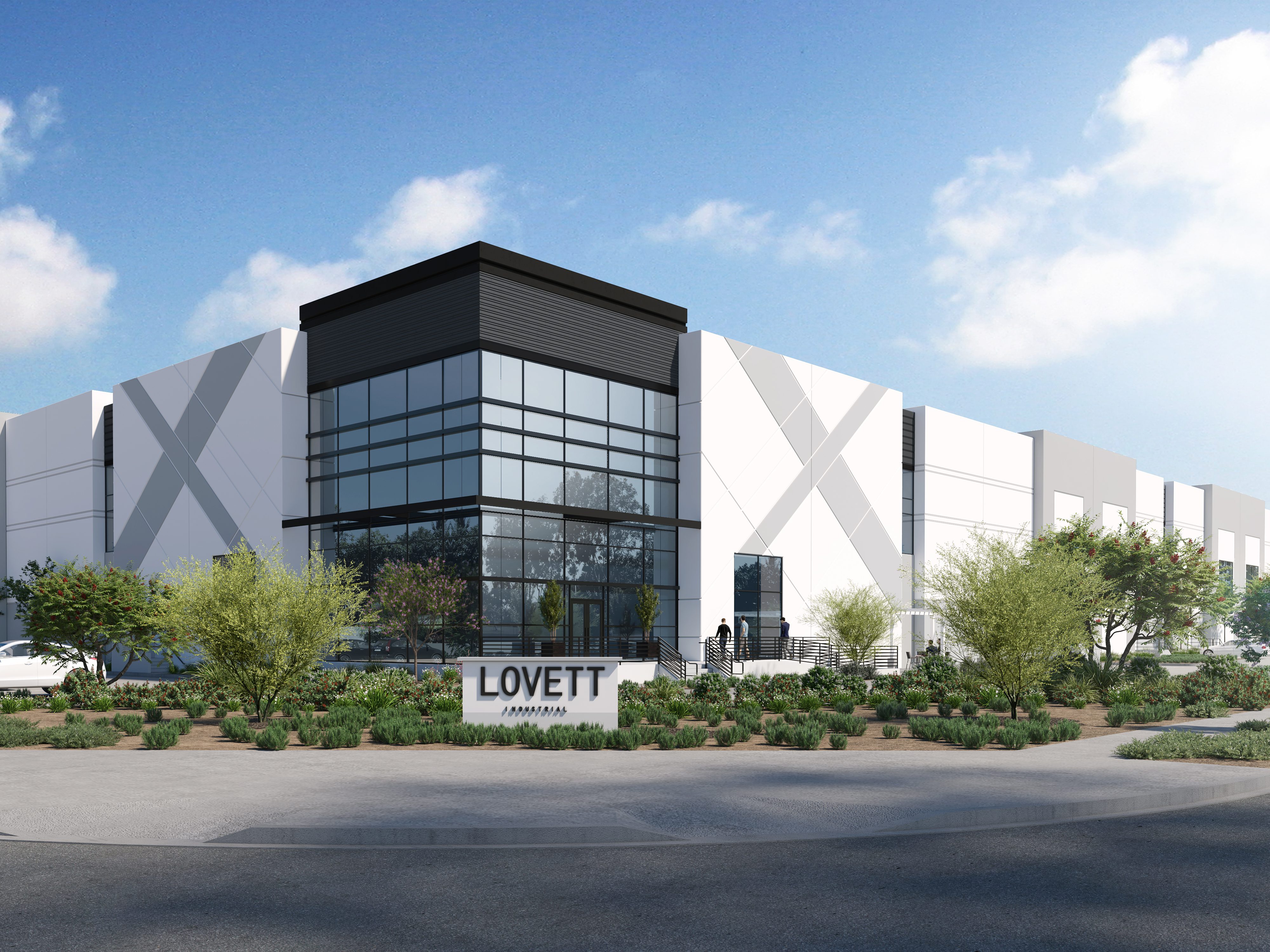How Incentives Boost Office Conversions
While the public sector works on eliminating hurdles, these projects are becoming increasingly diverse.

Ashley Dunn, Principal & Director of Workplace, Dyer Brown & Associates. Image courtesy of Dyer Brown & Associates
A growing number of cities, states and now the federal government are looking more closely at converting unused or obsolete office space. Which should not come as a surprise: The national office vacancy rate reached 18.2 percent in November, up 190 basis points year-over-year, according to CommercialEdge. Some major cities face even higher vacancies.
Coupled with a national housing shortage and an affordability crisis, most of the incentives aim for office-to-residential conversions. But there are other potential uses being considered, including educational, both K-12 and university-level, and student housing; hotels; data centers; industrial; lab and life science space.
“I think the real challenge is going to be whether or not the private developers and local governments can really partner together to make that work financially,” said Ashley Dunn, principal & director of workplace at Dyer Brown & Associates in Boston. “People don’t recognize the complexities involved.”
“There’s some uncertainty around whether putting that kind of cash into a property to convert it to residential is financially viable,” she added.
READ ALSO: Office Conversions Surge
While there have been fewer office-to-residential conversions in Boston to date, Dunn said there has been “a huge uptick” over the past two to four years from office to lab space. That has slowed more recently due to the economic climate.

Michael Underhill, Chief Investment Officer, Capital Innovations LLC. Image courtesy of Capital Innovations LLC
Despite the complexities involved, Michael Underhill, chief investment officer at Capital Innovations LLC, an alternative investment management firm in Waukesha, Wis., said that about 15 percent of commercial office buildings in the 105 largest U.S. cities are suitable for residential conversion, offering the potential to add 171,470 units, or almost half of 2022’s yield of units in multifamily buildings.
A recent CBRE study stated that 118 office-conversion projects—nearly half of them to multifamily—are expected to be completed in major U.S. cities this year. Between 2016 and 2022, the annual average was 41. The study found 60 million square feet of conversions is planned or underway, comprising 1.4 percent of total U.S. office inventory, up from 1.2 percent in the second quarter of 2022.
Since 2016, nearly 20,000 housing units have been created through office-to-residential conversions and the projects planned or underway are expected to add 21,000 units. To date, 48 percent of the conversion projects underway or planned are office-to-multifamily; 19 percent are office-to-life-science and 18 percent are office-to-mixed-use, according to CBRE.
READ ALSO: Are Suburban Office-to-Industrial Conversions Feasible?

Charles Bloszies, Principal, Office of Charles Bloszies, FAIA. Image courtesy of Office of Charles Bloszies, FAIA
“I think this issue is significant enough to get the attention of the policymakers,” said Charles Bloszies, principal at Office of Charles Bloszies, FAIA, in San Francisco. “Economically these projects just won’t happen without some incentives. And policymakers are seeing that and reacting.”
Some cities, such as Boston and Washington, D.C., are offering tax abatements. The Downtown Office to Residential Conversion pilot program in Boston will reduce taxes by up to 75 percent for up to 25 years for office properties converted into apartments. In D.C., the city is offering a 20-year tax abatement to developers who build more than 10 housing units.
In October, San Francisco Mayor London Breed announced a tax incentive proposal would be on the March 2024 ballot. It would waive the city’s transfer tax, which can be up to 6 percent on transactions exceeding $25 million, on buildings that have converted from non-residential use, including office, to residential use.
Seattle has selected several office conversion proposals and is drafting legislation, incentives and other programs that will aid the projects.
READ ALSO: 2023 Top Commercial Development Firms
Chicago is creating a tax-increment financing district as part of its LaSalle Street Reimagined program that would add housing to an area that is currently 85 percent office space. More than 1,000 apartments, with at least 30 percent of them affordable, would be developed.

Kelly Farrell, Global Leader of Residential Practice & Managing Director of the Los Angeles office, Gensler. Image courtesy of Gensler
“We’re seeing tax abatement programs in Philadelphia, where if you’ve got a conversion, you’ve got a 10-year tax abatement on that property, which is great,” said Kelly Farrell, global leader of Gensler’s residential practice & managing director in the firm’s Los Angeles office.
Other incentives offered by municipalities include cash grants for projects that meet certain criteria or waived permit fees or development charges.
Changing zoning to make it easier to develop residential housing in commercial zones, streamlining the process for developers, including creating dedicated teams to review and process applications for conversion projects are also part of the tools cities are utilizing.
In August, New York City Mayor Eric Adams laid out the administration’s plan that launched an Office Conversion Accelerator to expedite the conversion projects and speed up the process to create 20,000 new housing units by repurposing millions of square feet of empty office space. The city is also seeking to rezone Midtown South from only manufacturing and office space to allow housing to foster a 24/7 live-work community.
Peter Bafitis, managing principal at RKTB Architects in New York City, notes that tax incentives such as 421-a, which encourages developers to build affordable housing, have a sunset horizon and the New York State Legislature had not acted on a new version.
“This kind of major conversion in a large swath of the city is going to be difficult, if not impossible without state approval,” Bafitis said. “Hopefully in 2024 we’ll see the passage of some of those necessary things that are going to be required both on the state and city to facilitate this and incentives have to be part of the package. If we’re lucky, things might begin in 2025 or 2026 and last for another 10 to 15 years if Lower Manhattan is any guide.”
He noted in the 1990s, when the city was seeking to bring more housing to Lower Manhattan, the former 421-g tax incentive program provided tax exemption and abatement for the conversion of commercial buildings, or portions of buildings, into multifamily residences. It expired in 2006.

Vanbarton Group has completed Pearl House, a 588-unit ultra luxury rental building that is the largest office-to-residential conversion to date in New York City. Located in the Seaport district in Lower Manhattan, the property used to be a 26-story, 525,000-square-foot office building at 160 Water St. that was built in the 1970s. Vanbarton Group hired Gensler to design the conversion. Image by Williams New York, courtesy of Gensler
“What they were trying to do was deal with the vacant and obsolete offices in Lower Manhattan but to also create a 24-hour neighborhood in a place in the city where that had simply never existed before. It really was a major kind of social transformation, and you know what, it worked,” he told Commercial Property Executive.
State and federal actions
In California, the state legislature has appropriated $400 million in incentives for conversions, with $105 million earmarked for affordable housing. The legislature is considering the Office to Housing Conversion Act, that would facilitate and speed office conversions and require 10 percent of the new housing to be set aside for affordable units.
Steven Paynter, a principal at Gensler in its Toronto office and Building Transformation & Adaptive Reuse leader, said he has not seen other state programs yet but there will start to be some because the federal Department of Energy lending program announced in October by the Biden-Harris administration has to be administered through state-level entities.
The DOE program was among other initiatives spread across more than 20 federal programs stemming from six federal agencies, that can be used to support conversions included in the Commercial to Residential Federal Resources Guidebook.
The programs include low-interest loans, loan guarantees, grants and tax incentives. Some may be used together with federal programs as well as state and local offerings to increase the economic viability of conversion projects.
“You can coordinate with the Inflation Reduction Act,” said Gensler’s Farrell. “You can start to take credits for multifamily dwellings and whether that’s looking at Energy Star or DOE Zero energy provisions, you can start to take those into your conversion as well. There are provisions for renewables, solar, wind energy storage for those buildings and alternative fuel.”
Some of the federal funding programs include:
- The Department of Transit has more than $35 billion in lending capacity available through two programs—the Transportation Infrastructure Finance and Innovation Act and Railroad Rehabilitation & Improvement Financing—for transit-oriented projects at below-market interest rates.
- HUD is updating information on how Community Development Block Grant funds can be used to boost housing supply, including the acquisition, rehabilitation and conversion of commercial properties to residential and mixed-use developments. States and localities also can access up to five times their annual CDBD allocation in low-cost loan guarantees. It also has an $85 million Pathways to Removing Obstacles to Housing program that can be tapped.
- The General Services Administration will expand on its Good Neighbor Program to promote the sale of surplus federal properties that buyers could potentially redevelop for residential use.

Sky terrace at Pearl House, the largest office-to-residential conversion to date in New York City. Image by Williams New York, courtesy of Gensler
Historic tax credits
“The White House guidelines also involve things like taking advantage of historic tax credits for building habilitations and we think that’s going to be a great tool, especially in this economic environment,” said Farrell. “You can really put this stack together that can make conversion possible.”

Michael Liu, Senior Partner & Design Principal, Architectural Team Inc. Image courtesy of Architectural Team Inc.
Michael Liu, senior partner & design principal at the Architectural Team Inc. in the Boston area, said the historic tax credits get certified through the National Park Service.
“The developer is entitled to 20 percent tax credit for the cost of the renovation which is the historic build,” he said. “The National Park Service has to be persuaded the building has historic significance. … I don’t think there is the same kind of affection for buildings of this era than they would be for buildings from the 1930s.”
The building should be at least 50 or 60 years old to qualify for the historic tax credits. That could eliminate some of the newer-era office towers, but those built earlier, in the 1960s or 1970s, might qualify.
Bloszies’ company, an architecture and structural design firm focused primarily on San Francisco, released a study and map detailing the feasibility of several buildings in and near the downtown core that might be candidates for office-to-residential conversion. In the firm’s study, Bloszies noted the most ideal candidates in San Francisco for conversion are older buildings with high ceilings and large operable windows.
He said that in California, owners of historic buildings can also apply for The Mills Act, which is administered and implemented by local governments for restoration and preservation of qualified historic buildings.
Lessons from Calgary
Even before the COVID-19 pandemic hit, Calgary, Canada, had faced a rising office vacancy rate due to a downturn in 2014 in the oil and gas industry. By 2020, Calgary had peaked at a 34 percent vacancy rate in its downtown and the city took action to address the 12 million square feet of vacant office space.

The Cornerstone at 909 Fifth Ave. S.W. is the first office-to-residential conversion property to be completed in Calgary, Canada. The apartment building will open in January. Image courtesy of the City of Calgary Downtown Strategy
City officials began meeting with a local economic development group for ideas to encourage building owners to do something different with their properties. Calgary worked with Gensler, which created an algorithm tool to determine which underperforming assets could be candidates for conversion.
Paynter said the city decided early on they needed to remove 50 percent of the current vacancy or about 6 million square feet of office space.
“Using our algorithm and by working with the local developer groups, we were able to determine the market could support about 3 million square feet of conversions. To meet the goals, they would have to incentivize the work to the tune of about $75 per square foot and remove any policy hurdlers and red tape,” he said. “The city moved very quickly to do this, securing funding by ‘investing in themselves’ and proving that short-term incentives would have a positive tax flow benefit down the line.”

Natalie Marchut, Manager at Strategy & Development for the City of Calgary’s Downtown Strategy. Image courtesy of City of Calgary’s Downtown Strategy
The city has invested $153 million in incentive funding to date, said Natalie Marchut, manager at Strategy & Development for the City of Calgary’s Downtown Strategy. The federal government has launched the Housing Accelerator Fund to help municipalities deliver residential units across the country.
Marchut said the city also removed a development permit for certain applications, saving 4 to 6 months in the review process.
“It also saves a ton of money because development permits are very expensive and it also provides the certainty of approval, which I think is the biggest win for the development community,” she said, pointing out that that is the only time a project can be appealed.
The city also created a dedicated staff to deal with the conversion applications to help streamline the process.
Since the program launched in September 2021, 13 conversions have been approved and a total of 17 for 2,300 units have been proposed. One conversion has changed a property to hotel use and Marchut said the city is also eyeing student housing and other uses, including arts and cultural, for the downtown buildings. The first property, The Cornerstone at 909 Fifth Ave. S.W., will open in January.
Paynter said Calgary and the tools the city is using can be a model for other municipalities.
“Almost all cities in North America face the exact same issue right now,” he said. “We’ve applied our model in over a dozen U.S. cities already, most prominently San Francisco.”









You must be logged in to post a comment.